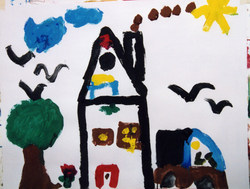The tree in children's drawings
The symbolic meaning of the tree
page 107 e.o.
The symbolism of the tree
The tree has always been a symbol of life, a symbol not thought of by man but naturally present in man. This derives from the period when early man/our ancestral primates were able to escape danger in the primordial forests by climbing a tree. Primordial instincts lead the toddler to 'climb' into his or her mother's arms when danger threatens. The tree is probably one of the oldest symbols of life and survival in the history of mankind. The outline of a tree with a trunk and branches that spread in all directions makes it possible to represent the growth and descendents of a family in the form of the family tree.
In old religieus and symbolic illustrations, the tree is the tree of life. There is the tree of good and evil in the Bible. The original inhabitants of North America, the Indians, used the tree as a totem having medicinal power. In northern Europe we have the tradition of the maypole that people dance around to celebrate the return of the spring. And a widespread custom is the Christmas tree with its lights in the dark of winter as a sign of hope.
The tree has always been important for people as a source of fruit and nuts. The tree gave its wood to build houses or boats. The tree provided warmth and the possibility of cooking food above a fire. The tree is often used as an example of the power and the significance of life, partly because it shows its age in the rings in its trunk. It is therefore not at all amazing that the tree is so often regarded as the representation of the course of human life.
Most psychological investigations have found similarities between the way in which a tree is drawn and the way we live. However, it remains an indication or an impression and does not give a detailed description of the course of someone's life with legal proofe of things in the present or things that could have happened in the past. That is because unconscious and unknown factors that we cannot yet see or know always play a role (in expressing a symbol).
The tree is both a symbol of protection and of life. It is the archetypal tree, the universal, natural, human characteristic of strenth, care, nurture and protection that every individual needs.
A drawing of a tree shows us the extent to which this archetypal force is or was present in a child. A child can also draw a 'tree of wishes' , so that the drawing works as a compensation. The child shows us what he needs and, to an extend, gives himself what he needs.
If children draw a tree next to a house, a figure or a flower, the tree often refers to the child's relation to his or her mother or to maternal protection. From about the time that the child is seven, we see that the tree moves increasely toward the side of the paper, meaning that the presence of the mother is less important in this phase of life.
